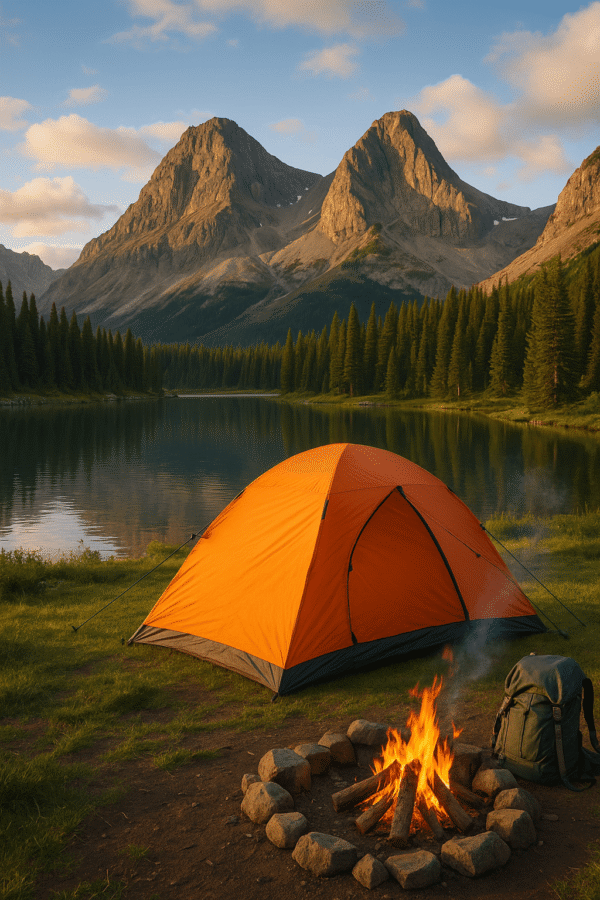📘 Table of Contents
What is Backcountry Camping Alberta?
Backcountry camping Alberta refers to camping in remote, undeveloped wilderness areas that require hiking or other non-motorized access, offering complete solitude away from established campgrounds and facilities.
- Remote wilderness camping beyond road access
- Self-sufficient outdoor experiences
- Minimal environmental impact practices
- Connection with pristine natural environments
Unlike traditional car camping, backcountry camping Alberta demands complete self-reliance and advanced outdoor skills. AI camping trip planner tools can help you prepare for these challenging adventures. You’ll carry everything you need on your back, from shelter and food to emergency supplies. This type of camping offers an unparalleled connection to nature, where the only sounds you’ll hear are wind through the trees, flowing water, and wildlife in their natural habitat. The experience transforms you, providing perspective and inner peace that’s impossible to find in developed areas.
Why Choose Alberta for Backcountry Camping?
Alberta stands out as one of the world’s premier backcountry camping destinations, offering diverse ecosystems from alpine meadows to dense forests, combined with well-managed wilderness protection and accessible trail networks.
- Five UNESCO World Heritage Sites including Banff and Jasper
- Over 600 designated wilderness areas and provincial parks
- Diverse ecosystems from mountains to prairies
- World-class wildlife viewing opportunities
- Well-maintained trail systems and clear regulations
Alberta’s geographical diversity is staggering – you can experience alpine tundra, old-growth forests, pristine lakes, and rolling foothills all within the same province. The Canadian Rockies alone contain some of the most spectacular mountain scenery on Earth, while the boreal forest regions offer a completely different but equally rewarding wilderness experience. The province’s commitment to conservation means these areas remain largely pristine, protected for future generations of adventurers.
💡 Pro Tip
Alberta’s backcountry offers four distinct seasons of camping opportunities. Summer provides the most accessible conditions, while winter camping offers unique experiences for advanced adventurers willing to face extreme cold and snow conditions.
Where are the Best Backcountry Camping Locations in Alberta?
Alberta’s top backcountry camping locations include Banff and Jasper National Parks, Kananaskis Country, and Willmore Wilderness Park, each offering unique landscapes and varying difficulty levels for different experience levels.
- Banff National Park – Iconic mountain landscapes with established backcountry campgrounds
- Jasper National Park – Largest park in the Canadian Rockies with extensive wilderness areas
- Kananaskis Country – Multi-use recreation area with diverse camping opportunities
- Willmore Wilderness Park – Pristine wilderness with minimal development
- Waterton Lakes National Park – Dramatic mountain-prairie interface
Each location offers distinct advantages for backcountry camping Alberta enthusiasts. AI hiking trail finders can help you discover hidden gems in these areas. Banff provides the most developed infrastructure and clearly marked trails, making it ideal for beginners. Jasper offers more remote experiences with longer approach hikes. Kananaskis combines accessibility with variety, while Willmore challenges even experienced campers with its rugged, unmarked terrain. The choice depends on your skill level, desired level of solitude, and specific wilderness experience goals.
What Essential Gear Do You Need for Backcountry Camping Alberta?
Essential backcountry camping Alberta gear includes a four-season tent, sleeping system rated for expected temperatures, water purification methods, navigation tools, emergency communication devices, and bear-safe food storage systems.
- Shelter System – Four-season tent, tarp, or bivy designed for mountain conditions
- Sleep System – Sleeping bag, pad, and pillow rated for expected temperatures
- Cooking Equipment – Lightweight stove, cookware, and fuel
- Water Management – Purification tablets, filter, or UV sterilizer
- Navigation Tools – GPS device, map, compass, and backup power
- Safety Equipment – First aid kit, emergency shelter, signaling devices
Quality gear can mean the difference between a memorable adventure and a dangerous situation in Alberta’s unpredictable wilderness. Your shelter must withstand sudden mountain storms, while your sleep system needs to keep you warm during unexpectedly cold nights. Water sources may be scarce or contaminated, making purification essential. Navigation equipment becomes critical when trails disappear or weather creates whiteout conditions.
🧰 Recommended Gear
- Mountain Hardwear Trango 3 — Four-season tent built for alpine conditions. Check on Amazon.
- Western Mountaineering UltraLite — Down sleeping bag rated to -18°C. Check on Amazon.
- Garmin inReach Explorer+ — Satellite communicator with GPS navigation. Check on Amazon.
How Do You Stay Safe While Backcountry Camping?
Backcountry camping Alberta safety requires thorough trip planning, proper gear selection, wilderness skills training, emergency preparedness, and understanding of local hazards including wildlife, weather, and terrain challenges.
- File detailed trip plans with trusted contacts
- Carry emergency communication devices
- Understand weather patterns and seasonal hazards
- Master navigation and route-finding skills
- Know wildlife safety protocols
- Practice wilderness first aid techniques
Safety in Alberta’s backcountry starts with proper preparation and continues with smart decision-making throughout your trip. Weather can change dramatically within hours, especially in mountain environments where afternoon thunderstorms are common. Hypothermia remains a risk even in summer due to sudden temperature drops and wet conditions. Understanding your limits and having multiple exit strategies can prevent minor problems from becoming life-threatening emergencies.
⚠️ Critical Safety Warning
Alberta’s wilderness can be deadly for unprepared visitors. Every year, search and rescue teams respond to emergencies that could have been prevented with proper planning, appropriate gear, and conservative decision-making. Never underestimate the power of mountain weather or overestimate your abilities.
What Permits and Regulations Apply to Backcountry Camping Alberta?
Backcountry camping Alberta requires specific permits for national parks, provincial parks, and some wilderness areas, with advance reservations recommended due to limited quotas designed to protect fragile ecosystems.
- National Parks – Mandatory backcountry permits and camping fees
- Provincial Parks – Permit requirements vary by location
- Public Land Use Zones – Free camping with specific restrictions
- Group Size Limits – Maximum 6-8 people depending on area
- Camping Restrictions – Designated sites only in sensitive areas
Understanding permit requirements prevents disappointment and potential fines during your backcountry camping Alberta adventure. National parks like Banff and Jasper require advance reservations, especially during peak summer months when popular trails fill up quickly. Public land camping guidelines offer additional options for more flexible trips. Provincial parks have varying requirements, with some requiring permits while others operate on a first-come, first-served basis. Always check current regulations before departing, as rules change seasonally and new restrictions may be implemented to protect sensitive areas.
How Do You Practice Leave No Trace in Alberta’s Backcountry?
Leave No Trace principles for backcountry camping Alberta include proper waste disposal, campsite selection, wildlife protection, fire safety, and minimizing your environmental impact to preserve wilderness areas for future generations.
- Pack out all trash including micro-trash and food scraps
- Use established campsites when available
- Camp on durable surfaces like rock, gravel, or sand
- Keep campsites small and inconspicuous
- Properly dispose of human waste using catholes or portable systems
- Use bear-proof food storage systems
Practicing Leave No Trace isn’t just about following rules – it’s about preserving the wilderness experience for everyone who follows in your footsteps. Alberta’s fragile alpine environments can take decades to recover from damage, while improper food storage can condition wildlife to associate humans with food, often leading to dangerous encounters. Your commitment to these principles helps maintain the pristine conditions that make backcountry camping Alberta so special.
📝 Important Note
In bear country, food storage isn’t just about Leave No Trace – it’s a critical safety issue. Improperly stored food can attract bears to campsites, creating dangerous situations for current and future campers. Always use approved bear canisters or hang food properly using the counterbalance method.
When is the Best Time for Backcountry Camping Alberta?
The optimal season for backcountry camping Alberta runs from July through September, offering the most stable weather, accessible trails, and comfortable camping conditions, though each season presents unique opportunities and challenges.
- Summer (July-August) – Peak season with warmest weather and clearest trails
- Fall (September-October) – Fewer crowds, stunning colors, but unpredictable weather
- Winter (November-March) – Extreme conditions requiring advanced skills and specialized gear
- Spring (April-June) – Muddy trails, river crossings, and lingering snow at elevation
Summer provides the most forgiving conditions for backcountry camping Alberta, with stable weather patterns and fully accessible trail networks. However, this popularity means crowded conditions at popular destinations and difficult permit acquisition. Fall offers spectacular scenery with autumn colors, but requires careful weather monitoring as winter storms can arrive suddenly. Winter camping appeals to experienced adventurers seeking solitude and unique experiences, but demands extensive preparation and cold-weather expertise.
How Do You Handle Wildlife Encounters Safely?
Safe wildlife encounters during backcountry camping Alberta require understanding animal behavior, proper food storage, making noise while hiking, carrying bear spray, and knowing specific protocols for different species including black bears, grizzly bears, mountain lions, and wolves.
- Make noise while hiking to avoid surprising animals
- Store food in bear-proof containers or hang properly
- Carry bear spray and know how to use it effectively
- Understand species-specific encounter protocols
- Never feed or approach wildlife
- Keep a clean campsite free of food odors
Wildlife encounters are both a highlight and a responsibility of backcountry camping Alberta. Bears, both black and grizzly, inhabit most wilderness areas and require specific protocols to ensure mutual safety. Mountain lions, though rarely seen, pose potential risks especially to solo travelers. Wolves generally avoid humans but may investigate campsites out of curiosity. Understanding animal behavior and maintaining proper precautions allows you to enjoy wildlife observations while staying safe.
🧰 Wildlife Safety Gear
- Counter Assault Bear Spray — EPA-approved bear deterrent with 30-foot range. Check on Amazon.
- BearVault BV500 — Lightweight bear canister approved for all North American parks. Check on Amazon.
Conclusion
Backcountry camping Alberta offers unparalleled wilderness experiences that challenge, inspire, and transform adventurous spirits willing to venture beyond the beaten path. From the towering peaks of the Canadian Rockies to the vast boreal forests, Alberta’s backcountry provides endless opportunities for those seeking true solitude and connection with nature. Success requires thorough preparation, proper gear, wilderness skills, and respect for the environment that makes these experiences possible.
Remember that backcountry camping is a privilege that comes with significant responsibilities. Every decision you make – from permit acquisition to campsite selection to waste disposal – impacts the wilderness experience for future generations. By following Leave No Trace principles, respecting wildlife, and prioritizing safety, you help preserve these incredible landscapes while creating memories that will last a lifetime.
Start with shorter, easier trips to build your skills and confidence before attempting more challenging adventures. Consider taking wilderness courses, practicing with your gear, and learning from experienced mentors. The investment in preparation pays dividends in safety, enjoyment, and success in Alberta’s magnificent backcountry.
📢 Ready to Start Your Adventure?
Begin planning your backcountry camping Alberta adventure today! Research permit requirements, invest in quality gear, and start building the skills you need for safe wilderness travel. Alberta’s backcountry is waiting – are you ready to answer the call?
Affiliate Disclosure
Some links in this post may be affiliate links. As an Amazon Associate and partner with other programs, I may earn a commission if you make a purchase, at no extra cost to you. I only recommend tools and gear I believe in.

